ECO mode TOYOTA RAV4 PLUG-IN HYBRID 2023 Owners Manual
[x] Cancel search | Manufacturer: TOYOTA, Model Year: 2023, Model line: RAV4 PLUG-IN HYBRID, Model: TOYOTA RAV4 PLUG-IN HYBRID 2023Pages: 718, PDF Size: 167.55 MB
Page 8 of 718
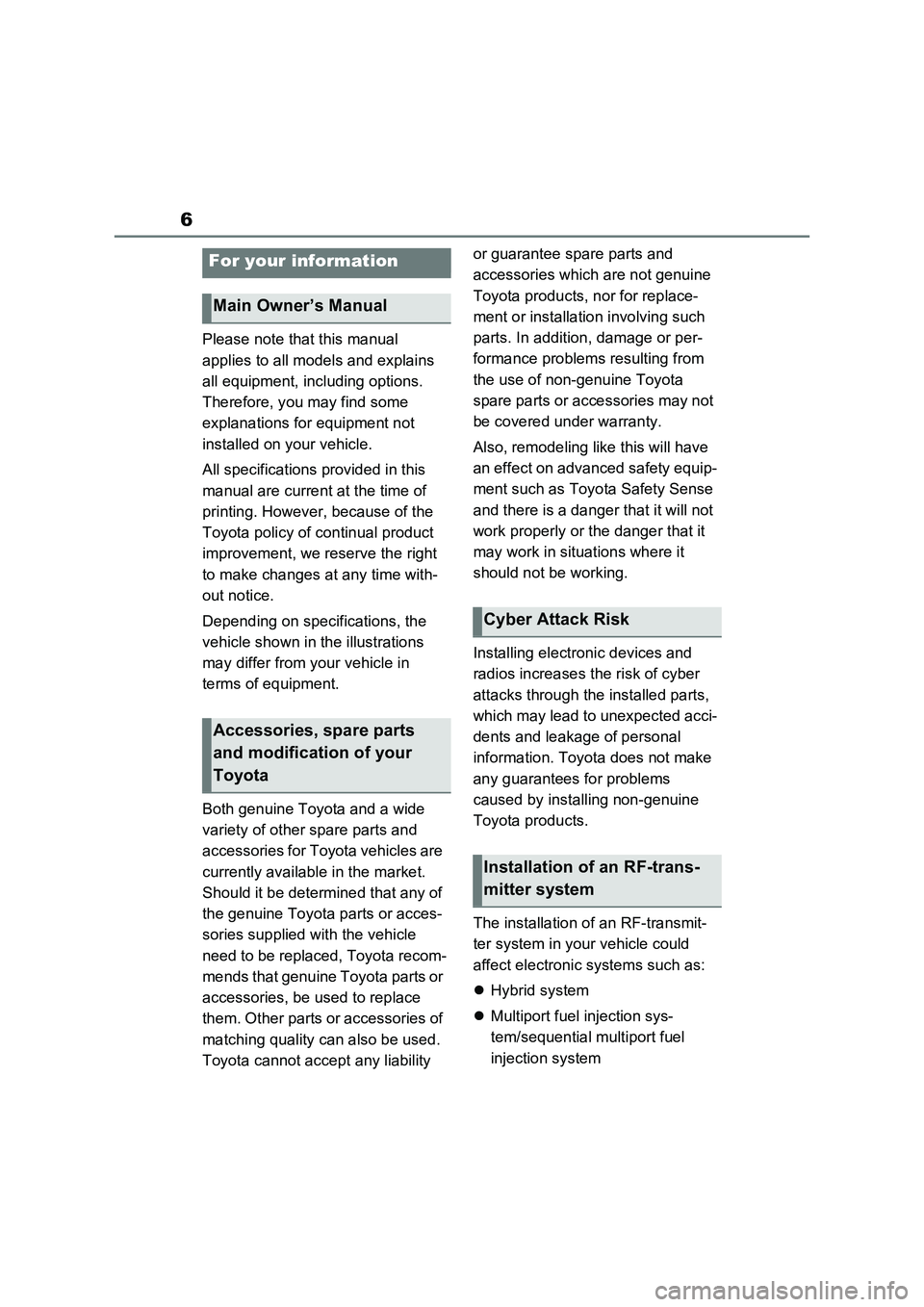
6
Please note that this manual
applies to all models and explains
all equipment, including options.
Therefore, you may find some
explanations for equipment not
installed on your vehicle.
All specifications provided in this
manual are current at the time of
printing. However, because of the
Toyota policy of continual product
improvement, we reserve the right
to make changes at any time with-
out notice.
Depending on specifications, the
vehicle shown in the illustrations
may differ from your vehicle in
terms of equipment.
Both genuine Toyota and a wide
variety of other spare parts and
accessories for Toyota vehicles are
currently available in the market.
Should it be determined that any of
the genuine Toyota parts or acces-
sories supplied with the vehicle
need to be replaced, Toyota recom-
mends that genuine Toyota parts or
accessories, be used to replace
them. Other parts or accessories of
matching quality can also be used.
Toyota cannot accept any liability or guarantee spare parts and
accessories which are not genuine
Toyota products, nor for replace-
ment or installation involving such
parts. In addition, damage or per-
formance problems resulting from
the use of non-genuine Toyota
spare parts or accessories may not
be covered under warranty.
Also, remodeling like this will have
an effect on advanced safety equip-
ment such as Toyota Safety Sense
and there is a danger that it will not
work properly or the danger that it
may work in situations where it
should not be working.
Installing electronic devices and
radios increases the risk of cyber
attacks through the installed parts,
which may lead to unexpected acci-
dents and leakage of personal
information. Toyota does not make
any guarantees for problems
caused by installing non-genuine
Toyota products.
The installation of an RF-transmit-
ter system in your vehicle could
affect electronic systems such as:
Hybrid system
Multiport fuel injection sys-
tem/sequential multiport fuel
injection system
For your information
Main Owner’s Manual
Accessories, spare parts
and modification of your
Toyota
Cyber Attack Risk
Installation of an RF-trans-
mitter system
Page 34 of 718
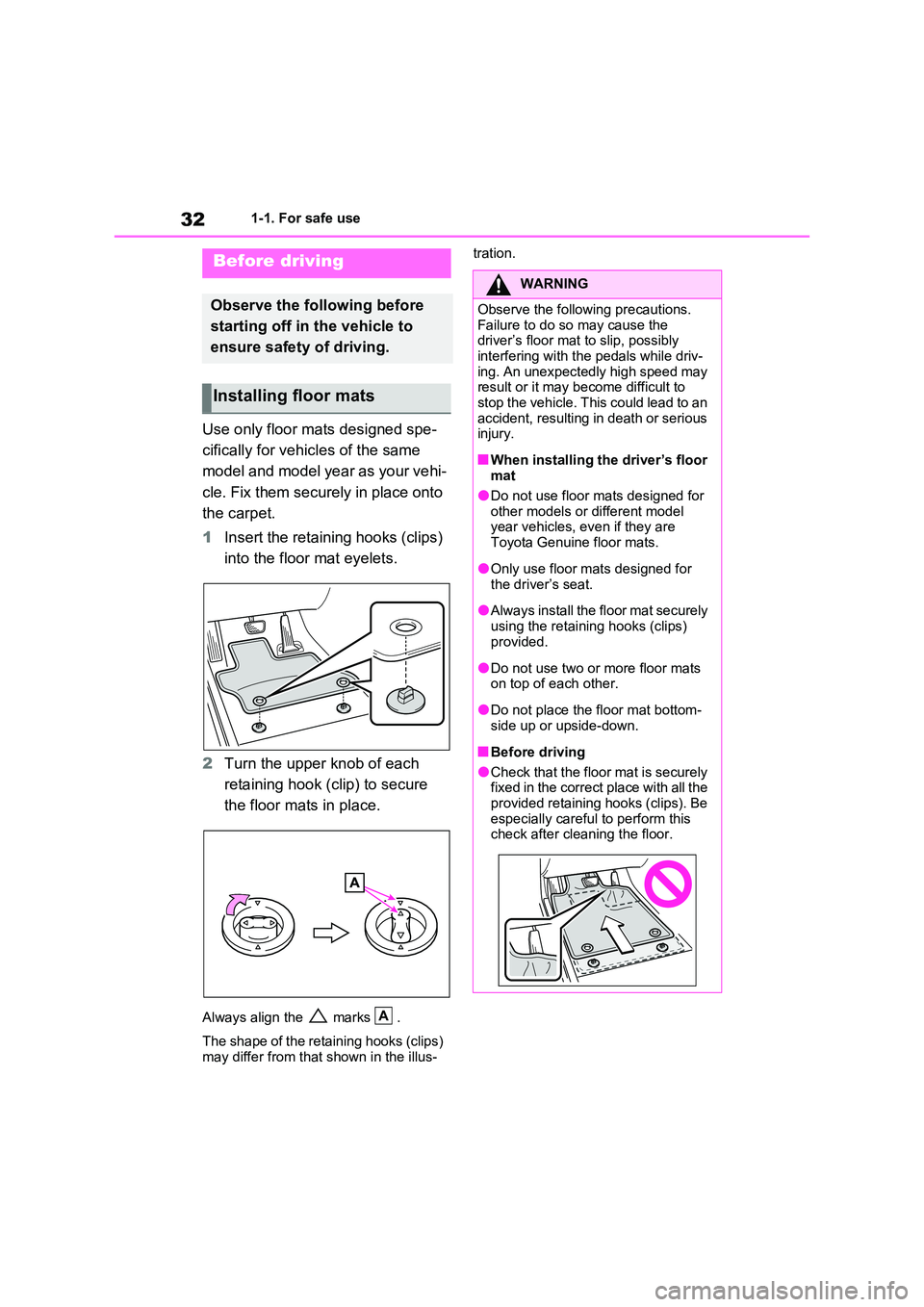
321-1. For safe use
1-1.For s afe us e
Use only floor mats designed spe-
cifically for vehicles of the same
model and model year as your vehi-
cle. Fix them securely in place onto
the carpet.
1 Insert the retaining hooks (clips)
into the floor mat eyelets.
2 Turn the upper knob of each
retaining hook (clip) to secure
the floor mats in place.
Always align the marks .
The shape of the retaining hooks (clips)
may differ from that shown in the illus-
tration.Before driving
Observe the following before
starting off in the vehicle to
ensure safety of driving.
Installing floor mats
A
WARNING
Observe the following precautions. Failure to do so may cause the driver’s floor mat to slip, possibly
interfering with the pedals while driv- ing. An unexpectedly high speed may result or it may become difficult to
stop the vehicle. This could lead to an accident, resulting in death or serious injury.
■When installing the driver’s floor mat
●Do not use floor mats designed for other models or different model year vehicles, even if they are
Toyota Genuine floor mats.
●Only use floor mats designed for
the driver’s seat.
●Always install the floor mat securely
using the retaining hooks (clips) provided.
●Do not use two or more floor mats on top of each other.
●Do not place the floor mat bottom-side up or upside-down.
■Before driving
●Check that the floor mat is securely fixed in the correct place with all the
provided retaining hooks (clips). Be especially careful to perform this check after cleaning the floor.
Page 88 of 718
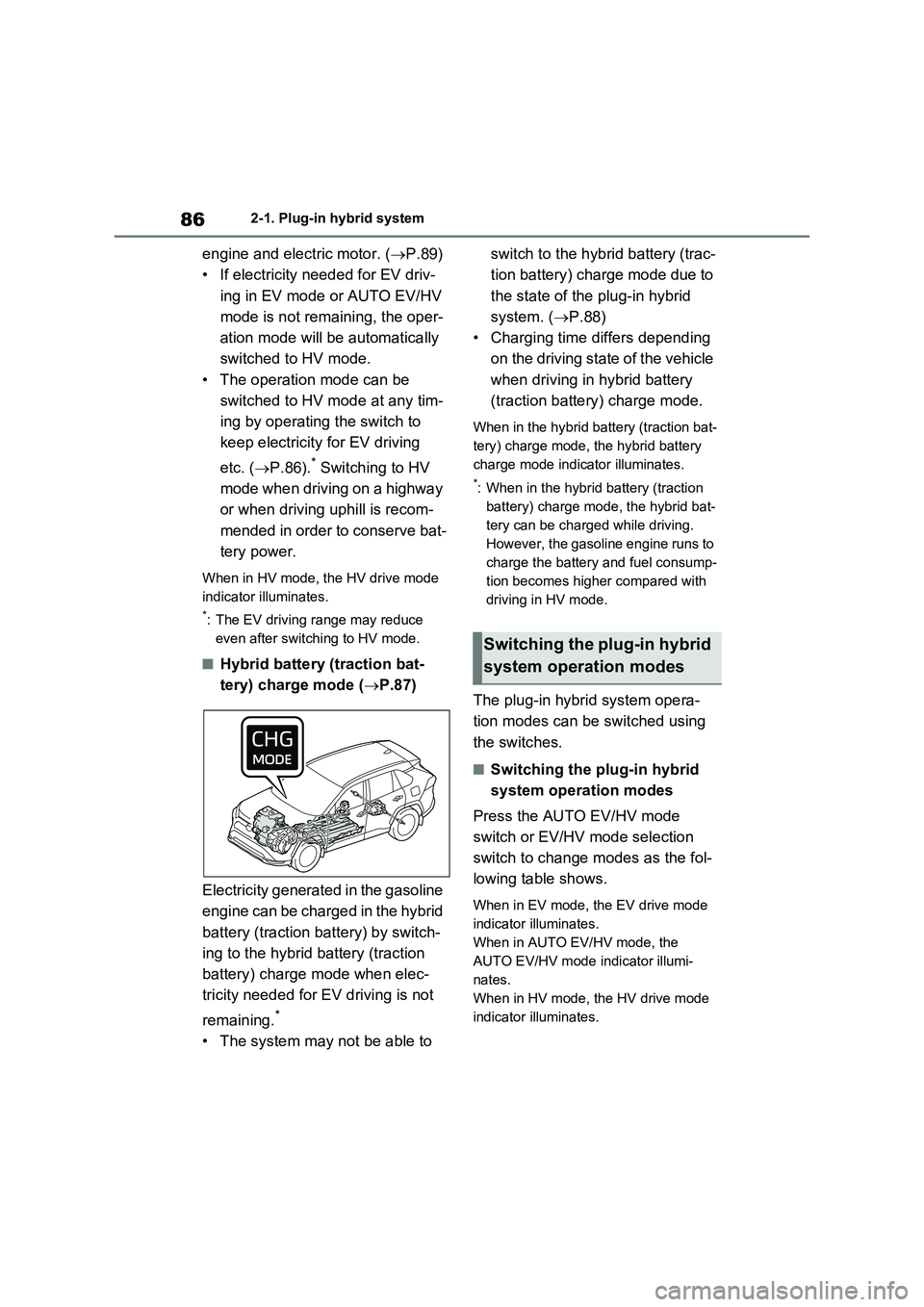
862-1. Plug-in hybrid system
engine and electric motor. (P.89)
• If electricity needed for EV driv-
ing in EV mode or AUTO EV/HV
mode is not remaining, the oper-
ation mode will be automatically
switched to HV mode.
• The operation mode can be
switched to HV mode at any tim-
ing by operating the switch to
keep electricity for EV driving
etc. (P.86).
* Switching to HV
mode when driving on a highway
or when driving uphill is recom-
mended in order to conserve bat-
tery power.
When in HV mode, the HV drive mode
indicator illuminates.
*: The EV driving range may reduce
even after switching to HV mode.
■Hybrid battery (traction bat-
tery) charge mode (P.87)
Electricity generated in the gasoline
engine can be charged in the hybrid
battery (traction battery) by switch-
ing to the hybrid battery (traction
battery) charge mode when elec-
tricity needed for EV driving is not
remaining.
*
• The system may not be able to switch to the hybrid battery (trac-
tion battery) charge mode due to
the state of the plug-in hybrid
system. (P.88)
• Charging time differs depending
on the driving state of the vehicle
when driving in hybrid battery
(traction battery) charge mode.
When in the hybrid battery (traction bat-
tery) charge mode, the hybrid battery
charge mode indicator illuminates.
*: When in the hybrid battery (traction
battery) charge mode, the hybrid bat-
tery can be charged while driving.
However, the gasoline engine runs to
charge the battery and fuel consump-
tion becomes higher compared with
driving in HV mode.
The plug-in hybrid system opera-
tion modes can be switched using
the switches.
■Switching the plug-in hybrid
system operation modes
Press the AUTO EV/HV mode
switch or EV/HV mode selection
switch to change modes as the fol-
lowing table shows.
When in EV mode, the EV drive mode
indicator illuminates.
When in AUTO EV/HV mode, the
AUTO EV/HV mode indicator illumi-
nates.
When in HV mode, the HV drive mode
indicator illuminates.
Switching the plug-in hybrid
system operation modes
Page 91 of 718
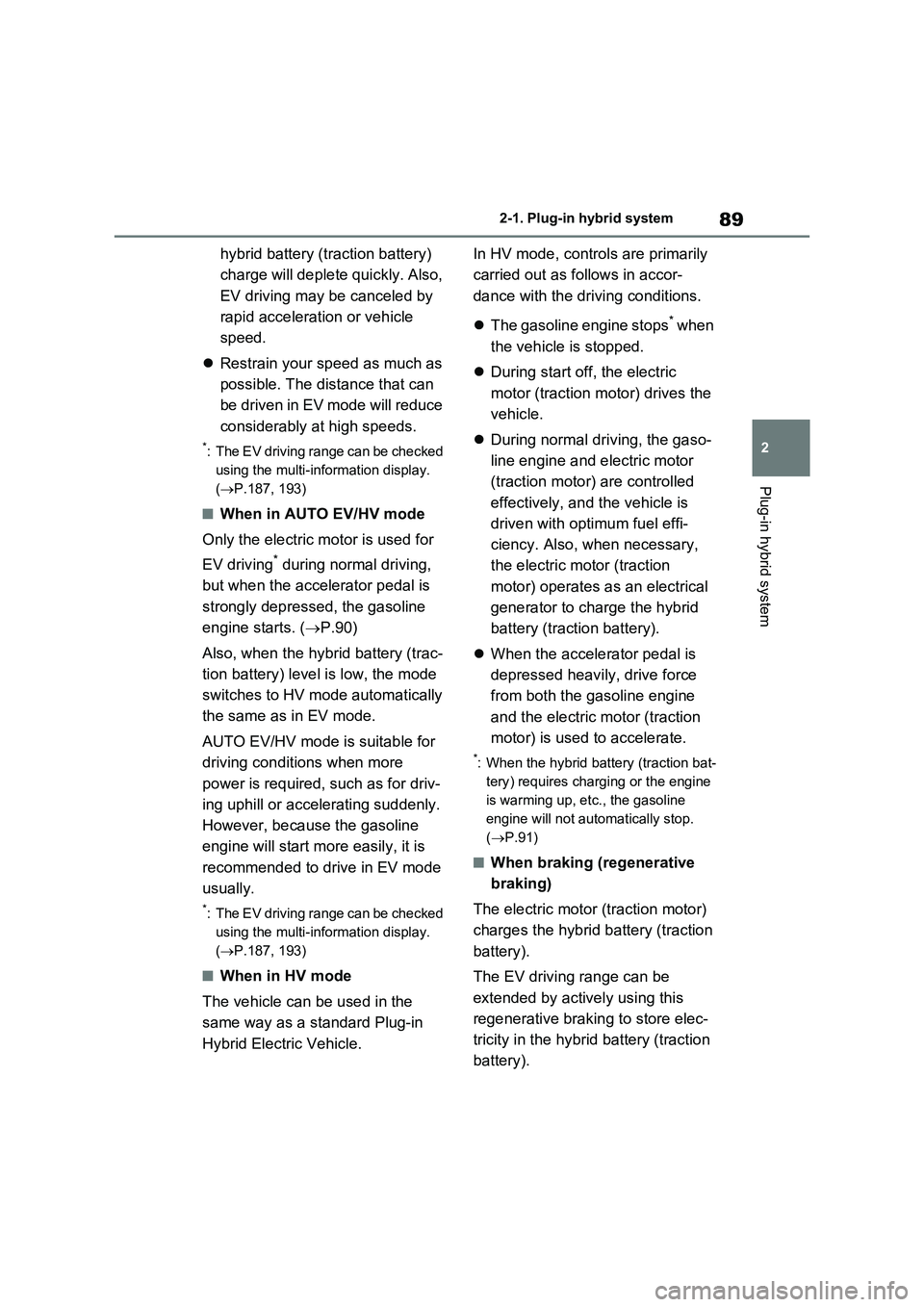
89
2 2-1. Plug-in hybrid system
Plug-in hybrid system
hybrid battery (traction battery)
charge will deplete quickly. Also,
EV driving may be canceled by
rapid acceleration or vehicle
speed.
Restrain your speed as much as
possible. The distance that can
be driven in EV mode will reduce
considerably at high speeds.
*: The EV driving range can be checked
using the multi-information display.
(P.187, 193)
■When in AUTO EV/HV mode
Only the electric motor is used for
EV driving
* during normal driving,
but when the accelerator pedal is
strongly depressed, the gasoline
engine starts. (P.90)
Also, when the hybrid battery (trac-
tion battery) level is low, the mode
switches to HV mode automatically
the same as in EV mode.
AUTO EV/HV mode is suitable for
driving conditions when more
power is required, such as for driv-
ing uphill or accelerating suddenly.
However, because the gasoline
engine will start more easily, it is
recommended to drive in EV mode
usually.
*: The EV driving range can be checked
using the multi-information display.
(P.187, 193)
■When in HV mode
The vehicle can be used in the
same way as a standard Plug-in
Hybrid Electric Vehicle.In HV mode, controls are primarily
carried out as follows in accor-
dance with the driving conditions.
The gasoline engine stops
* when
the vehicle is stopped.
During start off, the electric
motor (traction motor) drives the
vehicle.
During normal driving, the gaso-
line engine and electric motor
(traction motor) are controlled
effectively, and the vehicle is
driven with optimum fuel effi-
ciency. Also, when necessary,
the electric motor (traction
motor) operates as an electrical
generator to charge the hybrid
battery (traction battery).
When the accelerator pedal is
depressed heavily, drive force
from both the gasoline engine
and the electric motor (traction
motor) is used to accelerate.
*: When the hybrid battery (traction bat-
tery) requires charging or the engine
is warming up, etc., the gasoline
engine will not automatically stop.
(P.91)
■When braking (regenerative
braking)
The electric motor (traction motor)
charges the hybrid battery (traction
battery).
The EV driving range can be
extended by actively using this
regenerative braking to store elec-
tricity in the hybrid battery (traction
battery).
Page 92 of 718

902-1. Plug-in hybrid system
Moreover, as fuel consumption is
also reduced when in HV mode, the
regenerative braking system can be
used effectively.
■Regenerative braking
In the following situations, kinetic energy
is converted to electric energy and
deceleration force can be obtained in
conjunction with the recharging of the
hybrid battery (traction battery).
●The accelerator pedal is released
while driving with the shift lever in D or
S.
●The brake pedal is depressed while
driving with the shift lever in D or S.
■EV driving range
●The EV driving range is displayed on
the multi-information display.
(P.187, 193)
●The EV driving range changes in
accordance with the charge status of
the hybrid battery (traction battery),
the speed of the vehicle, etc.
●Even if there is enough charge
remaining in the hybrid battery (trac-
tion battery), EV driving may be can-
celed and both gasoline engine and
electric motor are used depending on
the situation. (P.90)
■EV indicator
The EV indicator comes on when the
vehicle is driven using only the electric
motor (traction motor) or the gasoline
engine is stopped.
The on/off operation of the EV indicator
can be changed. (P.206, 217)
■After EV mode has switched to HV
mode due to low hybrid battery
(traction battery) charge
If the hybrid battery (traction battery) is
regenerated by driving continuously
down a long slope, the EV driving range
etc. will be displayed on the multi-infor-
mation display and EV mode will be
automatically switched to.
If EV mode is not switched to even
though EV driving range is being dis-
played, EV mode can be switched to by
pressing the EV/HV mode selection
switch.
■Gasoline engine operation in EV
mode or AUTO EV/HV mode
Even if there is a sufficient amount of
electricity remaining in the hybrid battery
(traction battery) and EV driving range
(P.201, 213) is being displayed on the
multi-information display, EV driving
(driving using only the electric motor)
may be canceled and both gasoline
engine and electric motor are used
depending on the situation (EV driving
will be returned to automatically after EV
driving becomes possible again).
EV driving may be canceled automati-
cally in the following circumstances
*1:
●When vehicle speed is more than
approximately 135 km/h (84 mph).
●When power is needed temporarily,
for example when the accelerator
pedal is depressed firmly or when
accelerating suddenly.
*2
●When the temperature of the hybrid
system is high.
The vehicle has been left in the sun,
driven on a hill, driven at high speeds,
etc.
●When the temperature of the hybrid
system is low.
●When the heater is switched on when
the outside temperature is below
about -10°C (14°F).
●When the windshield defogger switch
is pressed. (P.431)
●When the system determines that the
Page 94 of 718
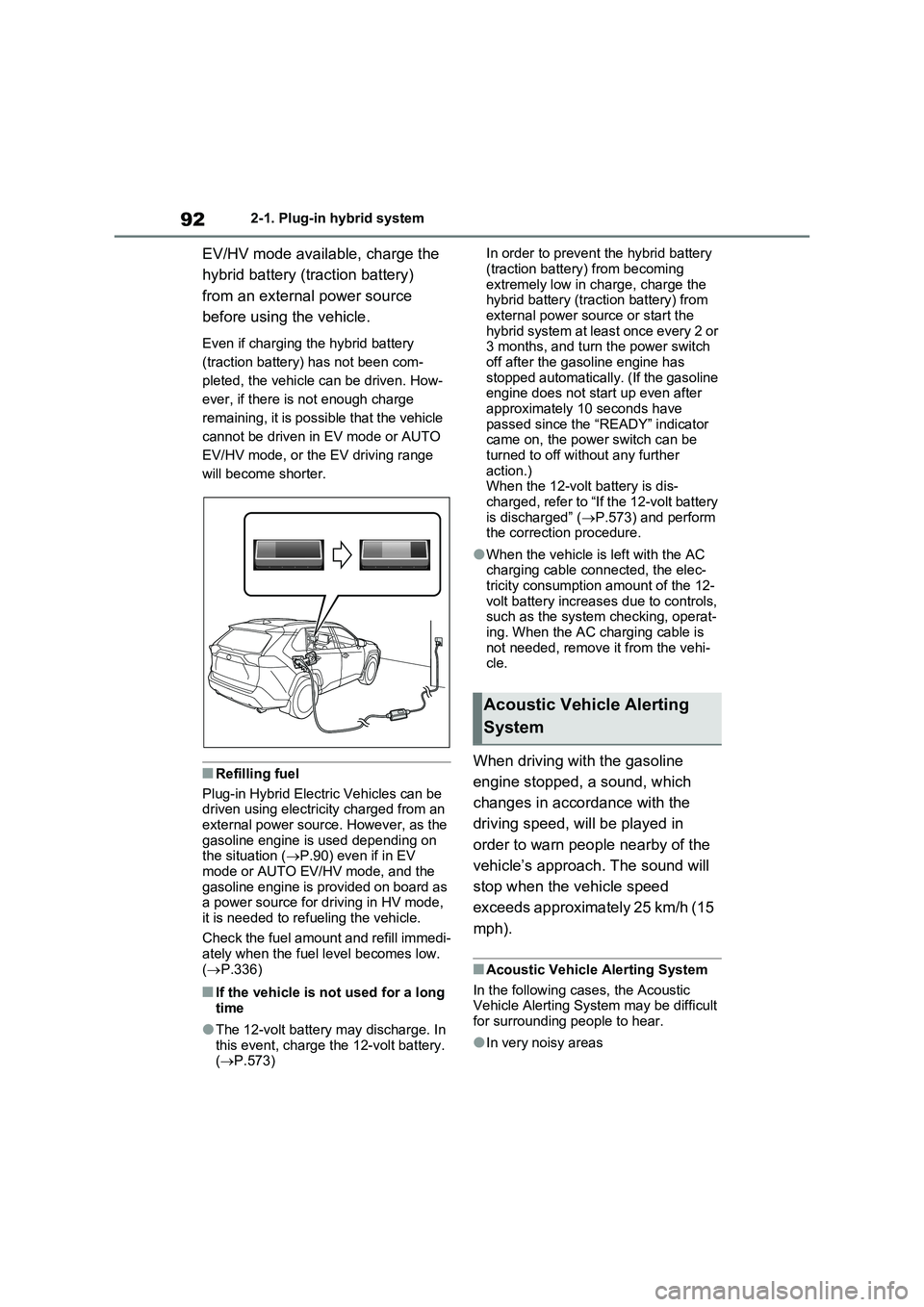
922-1. Plug-in hybrid system
EV/HV mode available, charge the
hybrid battery (traction battery)
from an external power source
before using the vehicle.
Even if charging the hybrid battery
(traction battery) has not been com-
pleted, the vehicle can be driven. How-
ever, if there is not enough charge
remaining, it is possible that the vehicle
cannot be driven in EV mode or AUTO
EV/HV mode, or the EV driving range
will become shorter.
■Refilling fuel
Plug-in Hybrid Electric Vehicles can be driven using electricity charged from an
external power source. However, as the gasoline engine is used depending on the situation ( P.90) even if in EV
mode or AUTO EV/HV mode, and the gasoline engine is provided on board as a power source for driving in HV mode,
it is needed to refueling the vehicle.
Check the fuel amount and refill immedi- ately when the fuel level becomes low.
( P.336)
■If the vehicle is not used for a long time
●The 12-volt battery may discharge. In this event, charge the 12-volt battery. ( P.573)
In order to prevent the hybrid battery
(traction battery) from becoming extremely low in charge, charge the hybrid battery (traction battery) from
external power source or start the hybrid system at least once every 2 or 3 months, and turn the power switch
off after the gasoline engine has stopped automatically. (If the gasoline engine does not start up even after
approximately 10 seconds have passed since the “READY” indicator came on, the power switch can be
turned to off without any further action.)When the 12-volt battery is dis-
charged, refer to “If the 12-volt battery is discharged” ( P.573) and perform the correction procedure.
●When the vehicle is left with the AC charging cable connected, the elec-
tricity consumption amount of the 12- volt battery increases due to controls, such as the system checking, operat-
ing. When the AC charging cable is not needed, remove it from the vehi-cle.
When driving with the gasoline
engine stopped, a sound, which
changes in accordance with the
driving speed, will be played in
order to warn people nearby of the
vehicle’s approach. The sound will
stop when the vehicle speed
exceeds approximately 25 km/h (15
mph).
■Acoustic Vehicle Alerting System
In the following cases, the Acoustic Vehicle Alerting System may be difficult for surrounding people to hear.
●In very noisy areas
Acoustic Vehicle Alerting
System
Page 98 of 718
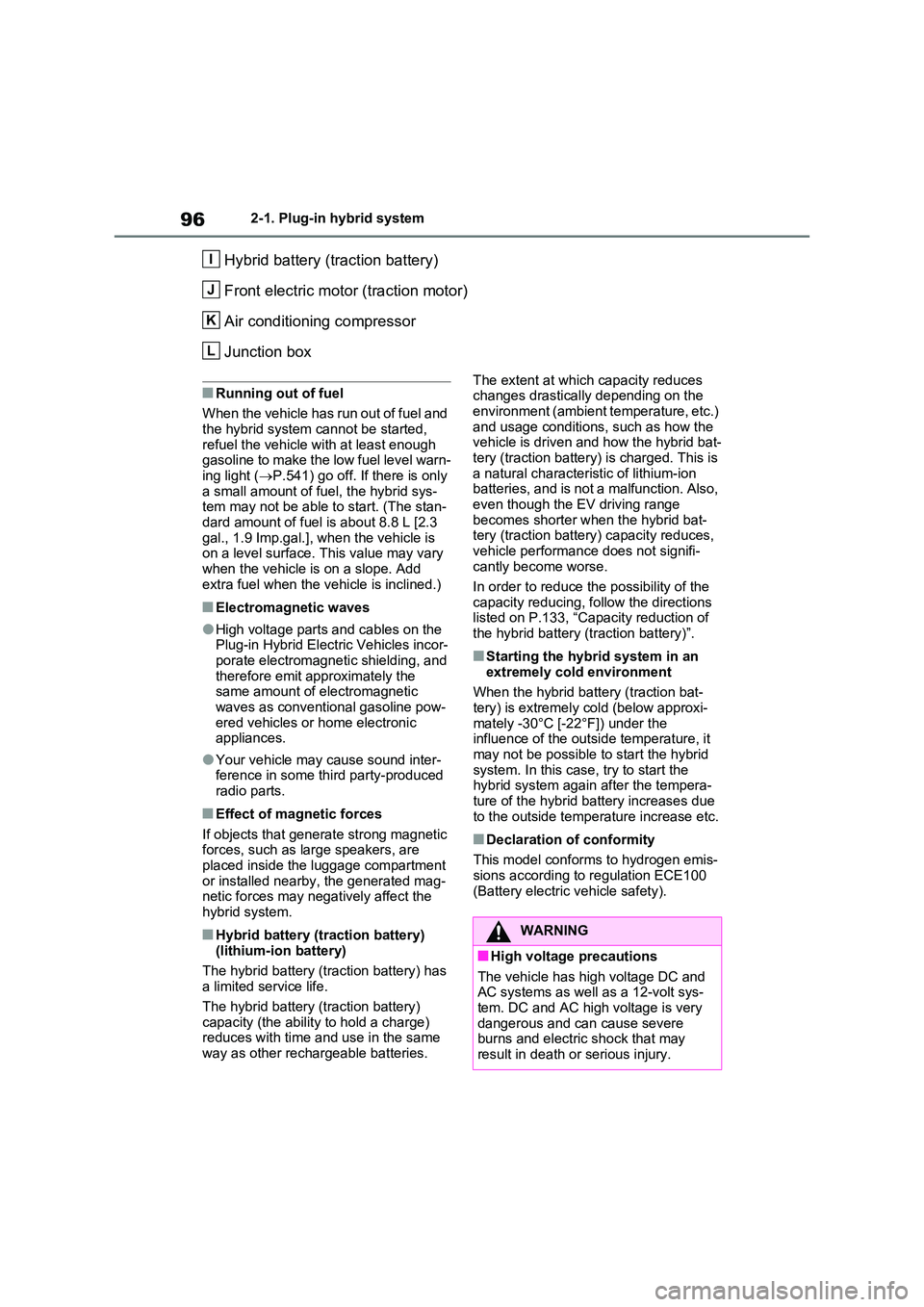
962-1. Plug-in hybrid system
Hybrid battery (traction battery)
Front electric motor (traction motor)
Air conditioning compressor
Junction box
■Running out of fuel
When the vehicle has run out of fuel and
the hybrid system cannot be started, refuel the vehicle with at least enough gasoline to make the low fuel level warn-
ing light ( P.541) go off. If there is only a small amount of fuel, the hybrid sys-tem may not be able to start. (The stan-
dard amount of fuel is about 8.8 L [2.3 gal., 1.9 Imp.gal.], when the vehicle is on a level surface. This value may vary
when the vehicle is on a slope. Add extra fuel when the vehicle is inclined.)
■Electromagnetic waves
●High voltage parts and cables on the Plug-in Hybrid Electric Vehicles incor-porate electromagnetic shielding, and
therefore emit approximately the same amount of electromagnetic waves as conventional gasoline pow-
ered vehicles or home electronic appliances.
●Your vehicle may cause sound inter-ference in some third party-produced radio parts.
■Effect of magnetic forces
If objects that generate strong magnetic forces, such as large speakers, are placed inside the luggage compartment
or installed nearby, the generated mag- netic forces may negatively affect the hybrid system.
■Hybrid battery (traction battery)
(lithium-ion battery)
The hybrid battery (traction battery) has a limited service life.
The hybrid battery (traction battery) capacity (the ability to hold a charge) reduces with time and use in the same
way as other rechargeable batteries.
The extent at which capacity reduces changes drastically depending on the
environment (ambient temperature, etc.) and usage conditions, such as how the vehicle is driven and how the hybrid bat-
tery (traction battery) is charged. This is a natural characteristic of lithium-ion batteries, and is not a malfunction. Also,
even though the EV driving range becomes shorter when the hybrid bat-tery (traction battery) capacity reduces,
vehicle performance does not signifi- cantly become worse.
In order to reduce the possibility of the
capacity reducing, follow the directions listed on P.133, “Capacity reduction of the hybrid battery (traction battery)”.
■Starting the hybrid system in an
extremely cold environment
When the hybrid battery (traction bat- tery) is extremely cold (below approxi-
mately -30°C [-22°F]) under the influence of the outside temperature, it may not be possible to start the hybrid
system. In this case, try to start the hybrid system again after the tempera-ture of the hybrid battery increases due
to the outside temperature increase etc.
■Declaration of conformity
This model conforms to hydrogen emis- sions according to regulation ECE100
(Battery electric vehicle safety).
I
J
K
L
WARNING
■High voltage precautions
The vehicle has high voltage DC and AC systems as well as a 12-volt sys-tem. DC and AC high voltage is very
dangerous and can cause severe burns and electric shock that may result in death or serious injury.
Page 102 of 718
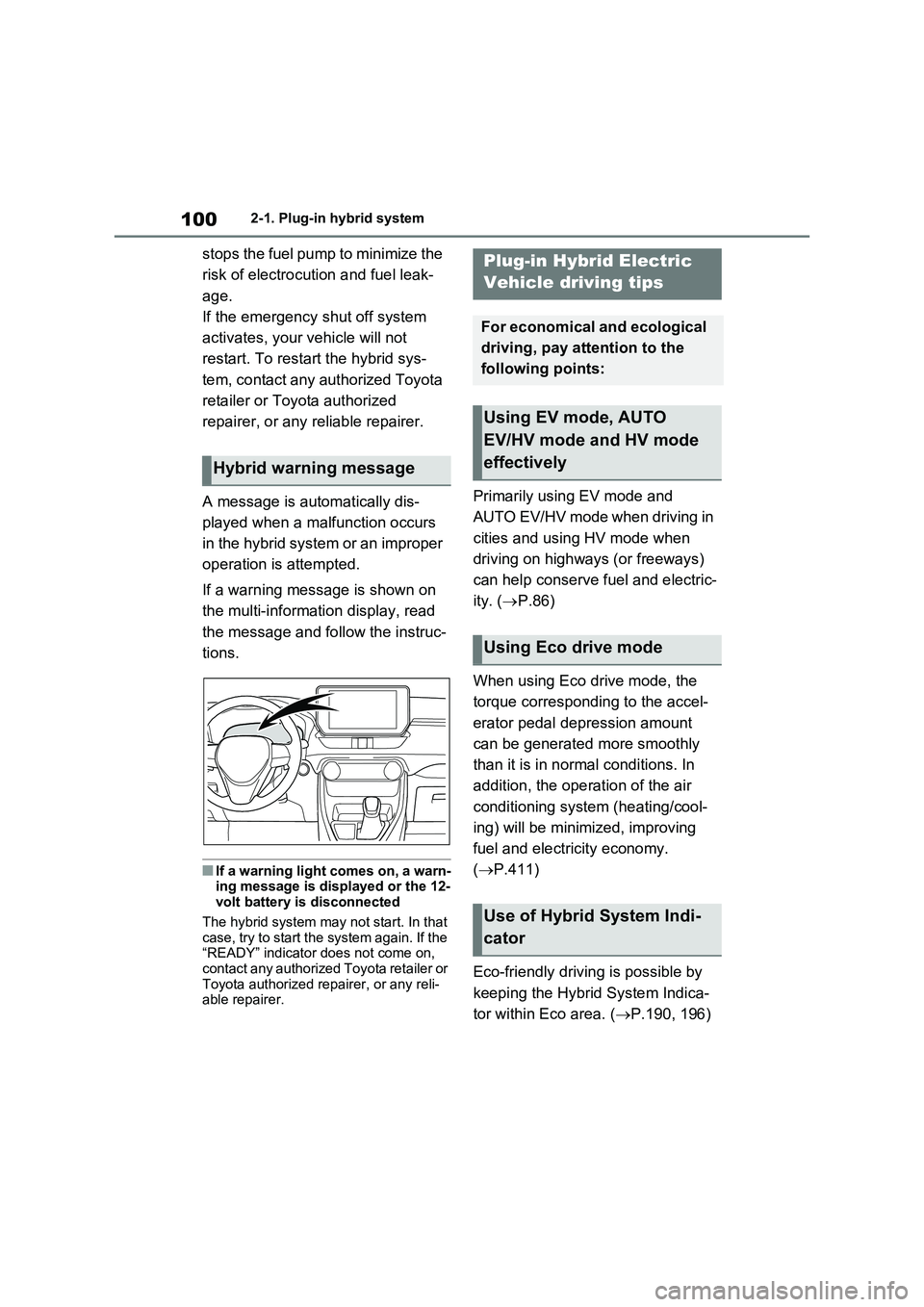
1002-1. Plug-in hybrid system
stops the fuel pump to minimize the
risk of electrocution and fuel leak-
age.
If the emergency shut off system
activates, your vehicle will not
restart. To restart the hybrid sys-
tem, contact any authorized Toyota
retailer or Toyota authorized
repairer, or any reliable repairer.
A message is automatically dis-
played when a malfunction occurs
in the hybrid system or an improper
operation is attempted.
If a warning message is shown on
the multi-information display, read
the message and follow the instruc-
tions.
■If a warning light comes on, a warn-
ing message is displayed or the 12-
volt battery is disconnected
The hybrid system may not start. In that
case, try to start the system again. If the
“READY” indicator does not come on,
contact any authorized Toyota retailer or
Toyota authorized repairer, or any reli-
able repairer.
Primarily using EV mode and
AUTO EV/HV mode when driving in
cities and using HV mode when
driving on highways (or freeways)
can help conserve fuel and electric-
ity. (P.86)
When using Eco drive mode, the
torque corresponding to the accel-
erator pedal depression amount
can be generated more smoothly
than it is in normal conditions. In
addition, the operation of the air
conditioning system (heating/cool-
ing) will be minimized, improving
fuel and electricity economy.
(P.411)
Eco-friendly driving is possible by
keeping the Hybrid System Indica-
tor within Eco area. (P.190, 196)
Hybrid warning message
Plug-in Hybrid Electric
Vehicle driving tips
For economical and ecological
driving, pay attention to the
following points:
Using EV mode, AUTO
EV/HV mode and HV mode
effectively
Using Eco drive mode
Use of Hybrid System Indi-
cator
Page 103 of 718
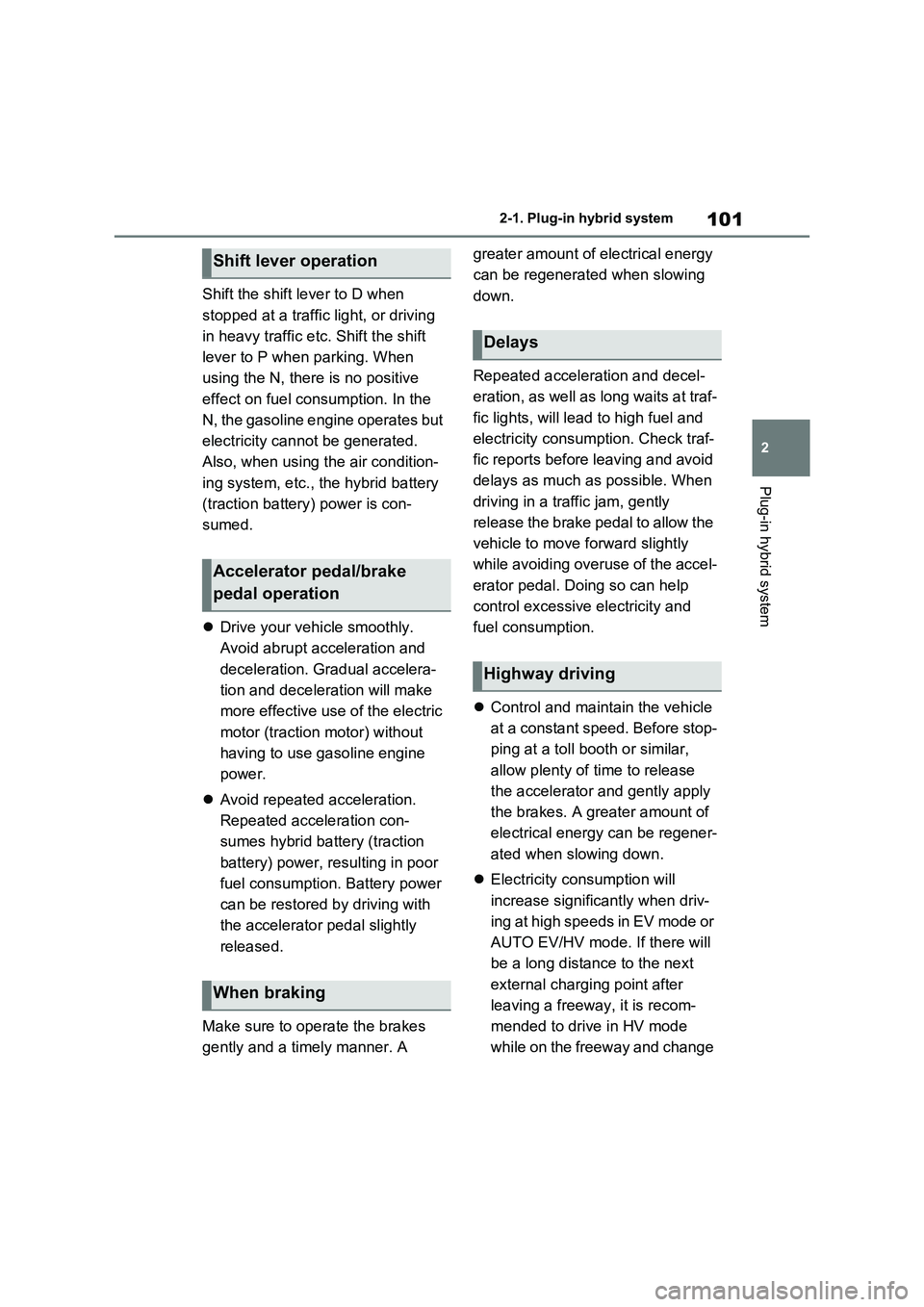
101
2 2-1. Plug-in hybrid system
Plug-in hybrid system
Shift the shift lever to D when
stopped at a traffic light, or driving
in heavy traffic etc. Shift the shift
lever to P when parking. When
using the N, there is no positive
effect on fuel consumption. In the
N, the gasoline engine operates but
electricity cannot be generated.
Also, when using the air condition-
ing system, etc., the hybrid battery
(traction battery) power is con-
sumed.
Drive your vehicle smoothly.
Avoid abrupt acceleration and
deceleration. Gradual accelera-
tion and deceleration will make
more effective use of the electric
motor (traction motor) without
having to use gasoline engine
power.
Avoid repeated acceleration.
Repeated acceleration con-
sumes hybrid battery (traction
battery) power, resulting in poor
fuel consumption. Battery power
can be restored by driving with
the accelerator pedal slightly
released.
Make sure to operate the brakes
gently and a timely manner. A greater amount of electrical energy
can be regenerated when slowing
down.
Repeated acceleration and decel-
eration, as well as long waits at traf-
fic lights, will lead to high fuel and
electricity consumption. Check traf-
fic reports before leaving and avoid
delays as much as possible. When
driving in a traffic jam, gently
release the brake pedal to allow the
vehicle to move forward slightly
while avoiding overuse of the accel-
erator pedal. Doing so can help
control excessive electricity and
fuel consumption.
Control and maintain the vehicle
at a constant speed. Before stop-
ping at a toll booth or similar,
allow plenty of time to release
the accelerator and gently apply
the brakes. A greater amount of
electrical energy can be regener-
ated when slowing down.
Electricity consumption will
increase significantly when driv-
ing at high speeds in EV mode or
AUTO EV/HV mode. If there will
be a long distance to the next
external charging point after
leaving a freeway, it is recom-
mended to drive in HV mode
while on the freeway and change
Shift lever operation
Accelerator pedal/brake
pedal operation
When braking
Delays
Highway driving
Page 104 of 718
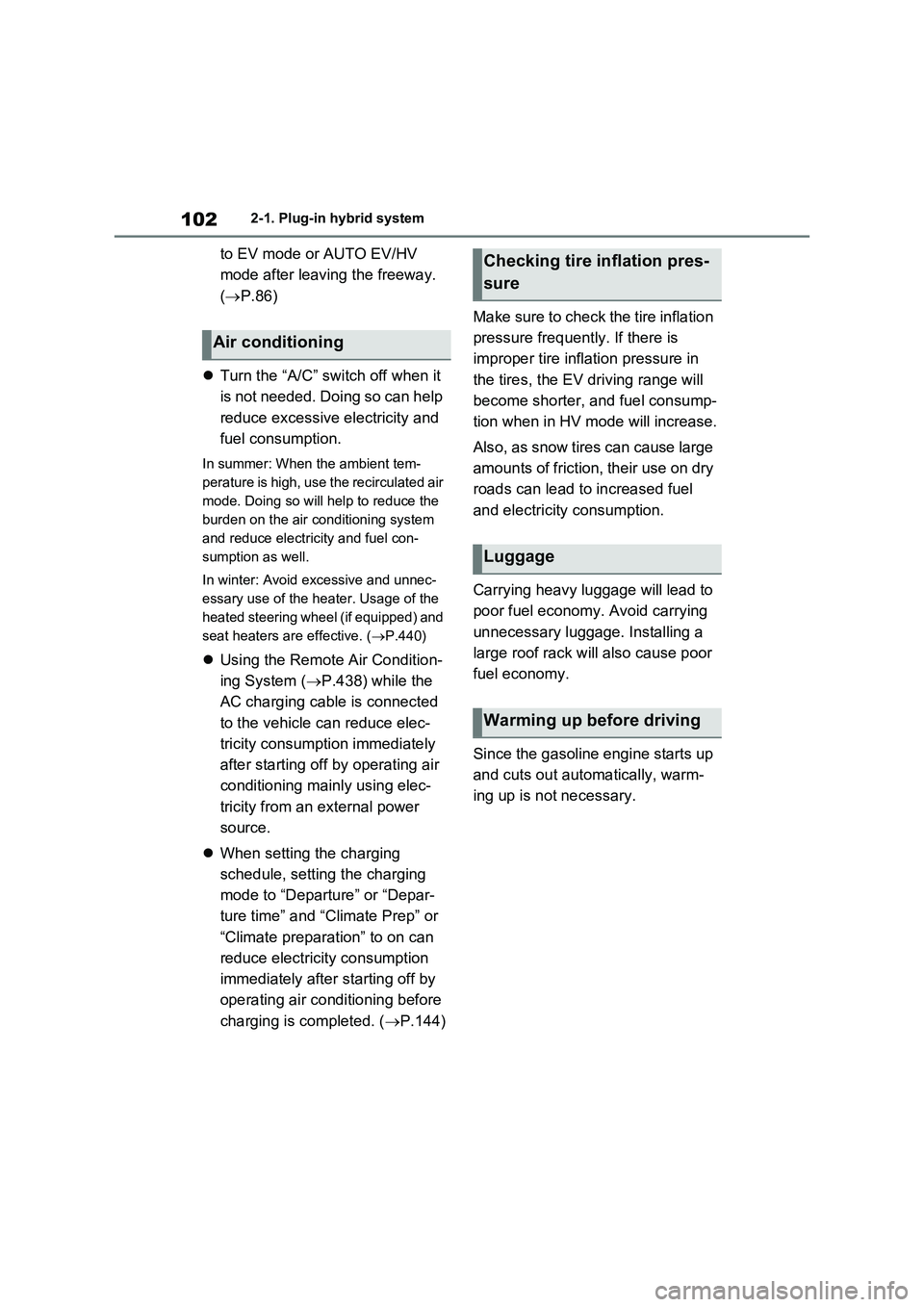
1022-1. Plug-in hybrid system
to EV mode or AUTO EV/HV
mode after leaving the freeway.
(P.86)
Turn the “A/C” switch off when it
is not needed. Doing so can help
reduce excessive electricity and
fuel consumption.
In summer: When the ambient tem-
perature is high, use the recirculated air
mode. Doing so will help to reduce the
burden on the air conditioning system
and reduce electricity and fuel con-
sumption as well.
In winter: Avoid excessive and unnec-
essary use of the heater. Usage of the
heated steering wheel (if equipped) and
seat heaters are effective. (P.440)
Using the Remote Air Condition-
ing System (P.438) while the
AC charging cable is connected
to the vehicle can reduce elec-
tricity consumption immediately
after starting off by operating air
conditioning mainly using elec-
tricity from an external power
source.
When setting the charging
schedule, setting the charging
mode to “Departure” or “Depar-
ture time” and “Climate Prep” or
“Climate preparation” to on can
reduce electricity consumption
immediately after starting off by
operating air conditioning before
charging is completed. (P.144)Make sure to check the tire inflation
pressure frequently. If there is
improper tire inflation pressure in
the tires, the EV driving range will
become shorter, and fuel consump-
tion when in HV mode will increase.
Also, as snow tires can cause large
amounts of friction, their use on dry
roads can lead to increased fuel
and electricity consumption.
Carrying heavy luggage will lead to
poor fuel economy. Avoid carrying
unnecessary luggage. Installing a
large roof rack will also cause poor
fuel economy.
Since the gasoline engine starts up
and cuts out automatically, warm-
ing up is not necessary.
Air conditioning
Checking tire inflation pres-
sure
Luggage
Warming up before driving